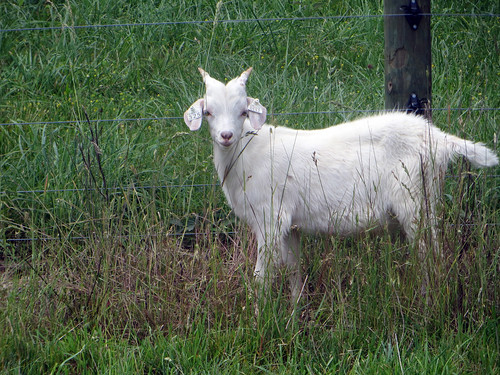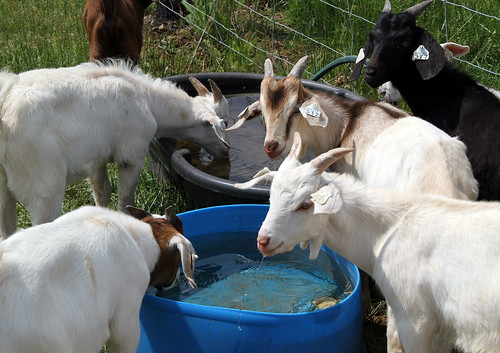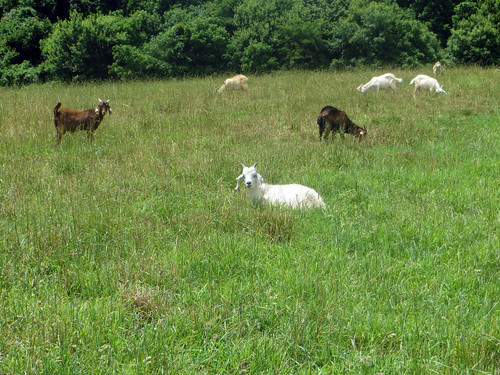The test officially started on June 14 when starting weights were determined and the triple deworming had enough time to kill most of the worms in the goats' systems. All of the goats should be starting the test (relatively) free from worms.
The goats were weighed on consecutive days (June 13 and 14) and starting weights were determined by averaging the two weights. Starting weights ranged from 29.4 to 68.2 lbs. and averaged 44.6 + 9.0 lbs. The median weight was 43.3 lbs.
FAMACHA, body condition, coat condition, dag, and fecal consistency scores were determined on June 13. These are the first scores that will be factored into the test results. FAMACHA scores ranged from 1 to 3 and averaged 1.8 + 0.6, unchanged from May 31. The median FAMACHA score was 2.
Body condition scores ranged from 2 to 3 and averaged 2.3 + 0.3. The median body condition score was 2.5. Body condition score is determined by accessing the degree of fat and muscle in the loin region. It is expected that some of the fleshier goats will lose some body condition as they adjust to a pasture-only diet.
Coat condition scores ranged from 2 to 2.5 and averaged 2.0 +0.1. The median coat condition score was 2 (average). It was difficult to access the condition of hair coats due to the rainy weather. On the day the goats were scored, their coats were wet.
Dag scores ranged from 0 to 1 and averaged close to zero. The median dag score was 0. Only one goat had a positive dag score and it was only 1. Dag scores are determined by estimating the amount of fecal soiling on the hindquarters of the goat. A dag score of 0 means there is no evidence of fecal soiling, whereas a dag score of 5 is the maximum amount of fecal soiling.
Fecal consistency scores ranged from 1 to 4 and averaged 3.7 + 0.8. The mean fecal consistency score was 4. A fecal score of 4 represents normal (firm) fecal pellets, whereas a fecal score of 1 is liquid feces. It is difficult to obtain a fecal sample if the goat has diarrhea (score 1).
Dag scores and fecal consistency scores are measures of diarrhea (scours). Scours can be a sign of some GI parasites. It can also be caused by diet, stress, and other diseases.
It was a tough week for the goats. There were numerous thunderstorms and temperature fluctuations. Several goats were treated for respiratory symptoms. On the day the goats were worked (June 13), there was a hail storm. The goats were released from the working pens and allowed to huddle in their port-a-huts until the storm subsided and work could be continued.
The goats are currently grazing a two acre paddock of cool season grasses. The four acres of dwarf sorghum grass that was planted on May 31 is being to grow. It will provide excellent forage when the weather gets hot and the cool season grasses reduce their growth.
The goats were worked by Susan Schoenian, Jeff Semler, David Gordon, Amy Garza, and Pam Thomas. Jeff weighed the goats. Susan scored the goats. Pam and David recorded data. Susan and Amy collected fecal samples.
Download June 13 (day-0) report
The goats were weighed on consecutive days (June 13 and 14) and starting weights were determined by averaging the two weights. Starting weights ranged from 29.4 to 68.2 lbs. and averaged 44.6 + 9.0 lbs. The median weight was 43.3 lbs.
 |
| Kiko buck consigned by Jarred Dennison (KY). |
FAMACHA, body condition, coat condition, dag, and fecal consistency scores were determined on June 13. These are the first scores that will be factored into the test results. FAMACHA scores ranged from 1 to 3 and averaged 1.8 + 0.6, unchanged from May 31. The median FAMACHA score was 2.
Body condition scores ranged from 2 to 3 and averaged 2.3 + 0.3. The median body condition score was 2.5. Body condition score is determined by accessing the degree of fat and muscle in the loin region. It is expected that some of the fleshier goats will lose some body condition as they adjust to a pasture-only diet.
Coat condition scores ranged from 2 to 2.5 and averaged 2.0 +0.1. The median coat condition score was 2 (average). It was difficult to access the condition of hair coats due to the rainy weather. On the day the goats were scored, their coats were wet.
 |
| Getting a drink of water. |
Dag scores ranged from 0 to 1 and averaged close to zero. The median dag score was 0. Only one goat had a positive dag score and it was only 1. Dag scores are determined by estimating the amount of fecal soiling on the hindquarters of the goat. A dag score of 0 means there is no evidence of fecal soiling, whereas a dag score of 5 is the maximum amount of fecal soiling.
Fecal consistency scores ranged from 1 to 4 and averaged 3.7 + 0.8. The mean fecal consistency score was 4. A fecal score of 4 represents normal (firm) fecal pellets, whereas a fecal score of 1 is liquid feces. It is difficult to obtain a fecal sample if the goat has diarrhea (score 1).
Dag scores and fecal consistency scores are measures of diarrhea (scours). Scours can be a sign of some GI parasites. It can also be caused by diet, stress, and other diseases.
It was a tough week for the goats. There were numerous thunderstorms and temperature fluctuations. Several goats were treated for respiratory symptoms. On the day the goats were worked (June 13), there was a hail storm. The goats were released from the working pens and allowed to huddle in their port-a-huts until the storm subsided and work could be continued.
 |
| Goats grazing a cool season grass paddock. |
The goats are currently grazing a two acre paddock of cool season grasses. The four acres of dwarf sorghum grass that was planted on May 31 is being to grow. It will provide excellent forage when the weather gets hot and the cool season grasses reduce their growth.
The goats were worked by Susan Schoenian, Jeff Semler, David Gordon, Amy Garza, and Pam Thomas. Jeff weighed the goats. Susan scored the goats. Pam and David recorded data. Susan and Amy collected fecal samples.
Download June 13 (day-0) report











